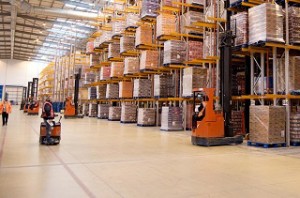From Guest Blogger Lana Hawkins: Trends in Sustainable Warehouse Design

The cycle of business
The process of recycling is one of the mainsprings of a sustainable business model. It is present in the stage of planning, construction, and day-to-day operations. For example, experts argue that business owners should consider redeveloping vacant buildings instead of building new facilities. Apart from lowering the carbon footprint, this enables warehouses to reduce the land use costs. Also, many businessmen opt for precast concrete and steel with a high recycled content. And once the warehouse is up and running, you can utilize returnable plastic containers for supply chain.
Zero Theorem
Today, solar panels are integrated in residential and commercial building around the world. Vast rooftops of warehouses present a great opportunity to maximize the solar input and go an extra mile. Namely, a net-zero building generates enough energy to support all operations, eliminating the dependency on the local power grid. This requires one to determine the optimal energy performance and set up the renewable energy strategy. Photovoltaic arrays can meet large demands and offer a payback in the couple of years’ time. Thus, upfront costs should not prevent you from thinking in the long-term.
All systems go
Focus on the crucial building systems like electricity, air-conditioning and water installations. A fan control system that controls high-volume, low-speed fans is one of the best ways to enhance the efficiency. By networking the fans an optimal facility’s temperature can be maintained all-year round. It is estimated that this reduces the heating and cooling costs up to 50 percent. Bear in mind also that the lighting accounts for much of the electricity consumption, so muse on clerestory glass, LED fittings and daylight tubes.
Smart moves
The surge of sustainable technology goes hand in hand with smart building solutions. This usually takes the form of the energy management systems, while the practice of submetering involves the installation of measuring devices onto machinery such as material lifts, forks lifts or vehicles. Web-based building management software handles and analyzes the information to identify opportunities for savings, hence, the consumption of the electricity, gas, water and other utilities can be monitored and optimized. As a result, managers and owners are able to gain insights into equipment energy use and the level of performance.
A fresh approach
The Coca-Cola Refreshments Distribution Center is a great example of the integrated sustainable approach. This huge area is dedicated to moving products, but it also includes some 20,000 square feet of offices. LEED Silver certification and other green standards were a top priority from the start. The innovative project encompassed seven core areas of business sustainability: Workplace design, beverage benefits, healthy lifestyle, community, water stewardship, energy efficiency and packaging. Just the plumbing fixtures have cut down the water usage by 35 percent, while the white roof prevents the heat island effect.
High time
Sustainable technology and best practices are beneficial for your business, customers and the planet. It is also becoming more affordable, and manufactured to suit any warehouse layout and business model. So, employ intelligent building management systems, endorse a holistic thinking, and avoid wasting both the energy and resources. Embracing the green way of doing business helps warehouse businesses gain an edge over the competition and make the company ready to face even the greatest environmental and economic challenges of our time.

From the article:
“Namely, a net-zero building generates enough energy to support all operations, eliminating the dependency on the local power grid.”
It would be interesting to know how many “net-zero” buildings are not connected to the grid.